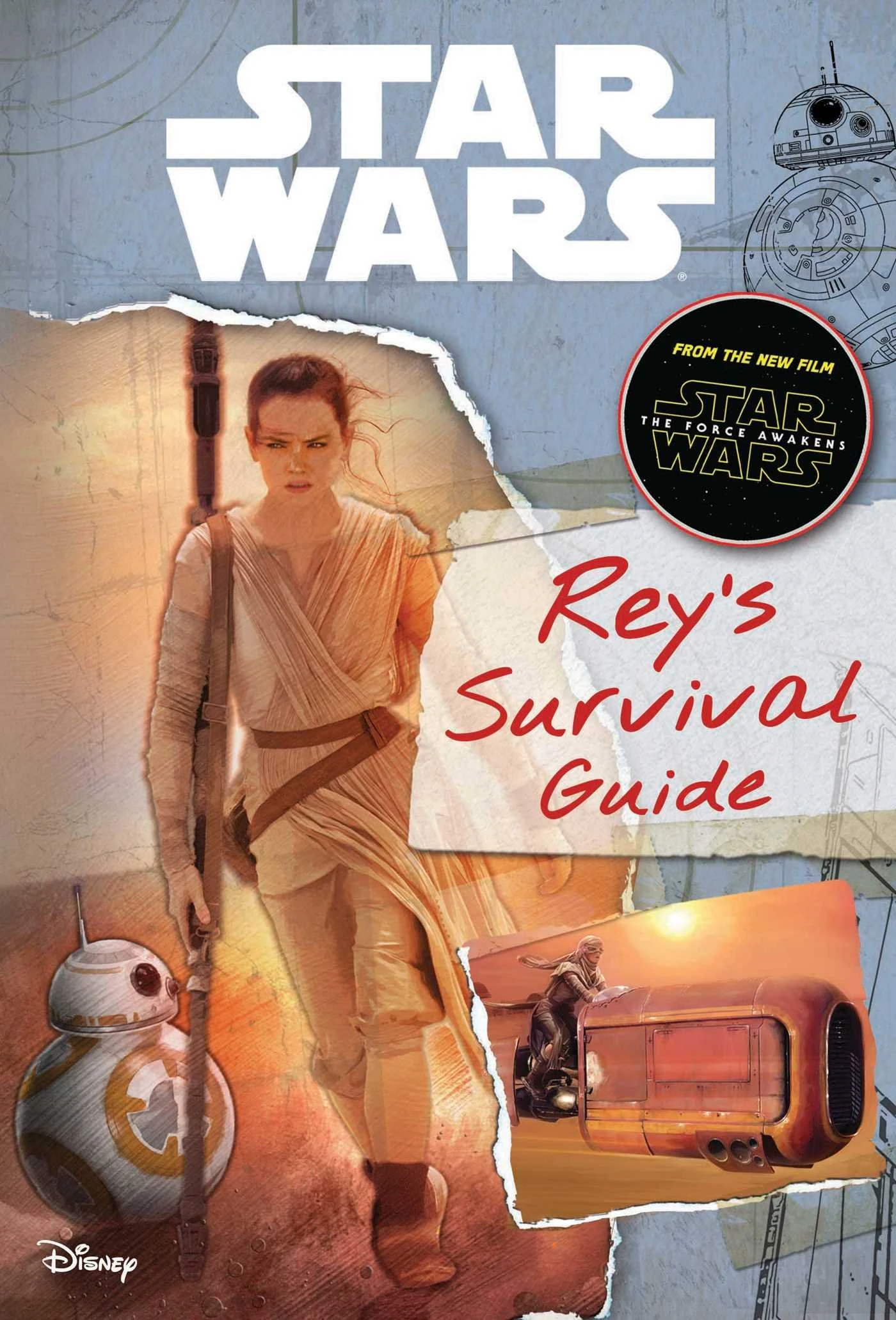Review: Rey’s Survival Guide (or, Is It A Spoiler That She Survived Jakku?)
SPOILER WARNING: Due to the nature of the book, and the closeness to the release of the film, you should treat this, with regards to spoilers, as you would any other article about The Force Awakens (this book does cover the events of the first third of the film, as well as some of Rey’s backstory). THIS IS YOUR LAST SPOILER WARNING.
‘Before you came to Jakku,’ writes Rey, ‘I bet you thought it was small and unimportant. And you were right. But up close, every planet is gigantic and full of mysteries – including ones that will kill you.’ And thus is the book summed up. Thank you, and good night.

Okay I should probably includes just a few more words here. As the name suggests, Rey’s Survival Guide, published by Egmont, details what it takes to survive Jakku. Written from the perspective of, well, Rey*, and addresses the reader as though they were new to Jakku – and to scavenging. It’s a neat touch that better helped me to feel like all this was real and that I could really go there (although the Aurebesh ‘wish you were here’ postcard did stretch credulity a bit). And that I could be friends with Rey and we’d go scavenging and we’d talk about flying and, erm, sand. And stuff, I don’t know what people talk about.
*Honestly how dare this book have such a descriptive, concise title that clearly demonstrates what it’s about, thus making my job of writing what it’s about all the more superfluous? Oblique names are clearly the way to go.
Joking aside, that quote is the perfect summation. Rey is – seriously last warning – a character who has no real memory of her past before being deserted on Jakku, and from the start it shows, with her often noting her keen desire to be whisked away by her family, and to see the rest of the galaxy. Small moments, but ones which resonate with me strongly. As the title suggests, the book focuses mainly on how to survive, focusing on how and what to scavenge, but these small, personal moments stand out as evocative, emotional oases in the overwhelming, lifeless desert of technical detail.
But for my taste, there could have been just a bit more sprucing of the technical stuff, with the foliage* of Rey’s personality. Of course, it should really be expected, because the book isn’t actually about her, but right now I want to hear more about Rey, about what she’s like, what her likes and dislikes are. From the film, we know that she’s longing to be with her family, and we get this, too, from the book – but pretty much just that. To be fair, we do learn a bit more about her skillset. We learn how she’s one of the best scavengers on Jakku, that she’s taught herself how to fight, how to fly and fix almost anything, and how she’s taught herself droidspeak and various other languages – which I found amusing, given that many on the internet has been labelling her a Mary Sue. It’s almost as if Jason Fry, the writer of the book, had witnessed it all and used a time machine to travel back and write this as an answer. And I realise that pretty much no one had seen the movie, or read the script, and as such knew very little about Rey as a character, knew nothing of how Daisy Ridley portrayed her, and consequently couldn’t provide much by way of characterisation for fear of getting it wrong. That’s entirely understandable, and does go some way of lessening my disappointment, but if you’re looking for that sort of thing, then this may not be your book.
* I’m really, really not good at metaphors.
Having said all that, there is one personal moment that stood out to me, and that’s the introduction of Captain Dosmit Raeh of the Tierfon Yellow Aces – or rather, her helmet. Raeh was Yellow-4, a Rebel pilot who flew, and died, at the battle of Jakku. Rey talks about how she would make up stories about her, and how she and her Raeh doll would seek out lost Rebels and rescue them. It’s a beautiful moment that went a long way to humanising her.
And then later, it is Raeh’s X-Wing that demonstrates the harshness of Jakku, and how Rey’s very practical approach wins out over sentimentality, to help her survive. The book has several fold-out pages – schematics of various vehicles. One details the AT-AT that she calls home – although going back to the lack of personalisation, she doesn’t say how, precisely, one goes about making an AT-AT a home. Another details Yellow-4’s X-Wing (which, if I remember correctly, was Raeh’s), with annotations that tells the reader what are the best parts to scrounge and how much they’re worth. It was somewhat jarring, at first, to see her treat Raeh’s vehicle like any old piece of junk, but thinking on it, it makes sense. She has to do what she needs to survive, and knows that no amount of sentimentality will make Jakku any more bearable. And she knows that she must impart this information to you, because it’s in her nature to help others survive for as long as possible.
And this is the mentality that’s hammered home over the course of the book – and, despite moaning about personal wants, the book amply delivers on what it set out to do. Nearly every page is dedicated to the how and the what of salvaging life, and is relentless in its documenting all of the technical details of various objects. Which, to be honest, is rather exhausting, and made it a bit of a slog to get through. To be fair, I did read this almost immediately after watching the new movie, and over the course of Christmas week – both of which may have played a part in my own difficulties.
Despite that, though, I appreciated the level of detail that the book went to, in order to make it seem realistic, and to convey information that – to my entirely inexperienced brain – seemed like very useful information to have in the tight spot that is Jakku. Indeed, I’m sure the survivalists of the galaxy far, far away would be very pleased to have this in their bunker. The minor details of the various artefacts including in the book – scraps of paper attached, detailing various orders and paperwork – are great. One of my favourite ‘how to’ parts was how to cook Imperial rations and the hazards thereof feel delightfully Imperial. And I loved the drawings that litter almost every page. Simple line sketches, for the most part, but no less beautiful because of it. And those pictures provide some real depth: the majority of pictures are of various pieces of scrap or salvage, and they’re on the simpler side of drawing. Living things and people – such as Finn – get a lot more detail, asw well as the few instances where she actually gets to draw some greenery. So in other words, the things she needs to survive are given the most basic of touches, but the things she needs to live are given greater attention and life.
(Yes, I’m aware how iffy it is to say Rey needs Finn to live. I mean only that I – along with practically everyone else on the internet – are shipping them so hard right now because THEY ARE ADORABLE TOGETHER. Search your feelings, you know this to be true).

To return to the original quote at the top, the book talks a fair amount about the mysteries of Jakku. Did you know, for example, that there is a secret Imperial base? That’s the talk in Niima Outpost, at least. No one knows for sure, as there are some strange people living in that area who attack any outsiders who come too close. Rey has her own ideas, though, as to what is happening there. She thinks a ship crashed during the battle, and those people are stormtroopers, still guarding the place all these years later. Who knows? Rey, of course Rey. She’s smart. Didn’t you see the movie?
Or have you heard of the Sitter? He’s a human who sits atop a plinth, day in, day out. No one quite knows why. Though personally I just think it might be to get away from the hot rocks. Try to catch an errant wind or two. He gets free food, though, so perhaps he’s doing it to be odd enough to garner said food? Or what about the Sacred villages? Where people believe the Hutts are gods and, would you believe, that the Jedi were real? What exactly are these Jedi-worshippers up to?
What I find most intriguing about it all is that I get the distinct impression that there will never be any answers to these mysteries – and that’s a good thing. We used to have an Expanded Universe that left no stone unturned, which was great, in a different way, but did lead to a lot of arguments, and somewhat conversely made the galaxy seem rather small. Right now, the fact that there are such mysteries make Jakku seem larger than it probably really is, and makes the new galaxy appear grander than it currently is, and frankly that’s what I want.
Star Wars: Rey’s Survival Guide, published by Egmont, is out now everywhere. With thanks to Egmont UK for providing a copy for review purposes.
Author: Michael Dare
Michael Dare is a writer, lives in the UK, and has been slowly coming to terms with the realization that he is not Sherlock, but Watson. He loves Star Wars, dislikes blue milk. Enjoys jumping sharks. Survives on the tears of sexist men, and cheeseburgers.
